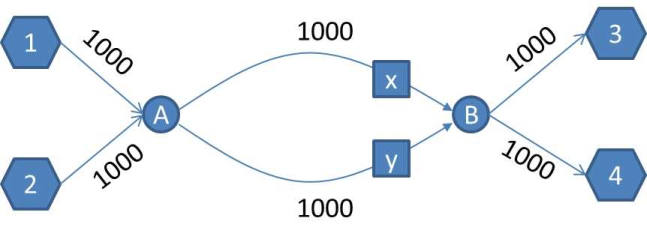According to Wardrop's equilibrium condition, the link volumes are determined explicitly.
Specifically, in equilibrium, the following conditions apply to each OD pair:
-
All routes used have the same travel time.
-
Travel time on unused routes is equal to or greater than travel time on used routes.
On the other hand, the path volumes are not necessarily unique.

Image 88: Example for the proportionality with balanced link volumes
Zones 1 and 2 are connected to node A, the zones 3 and 4 are connected to node B. A and B are connected by the two links x and y, which have the same VDF. Demand is 500 trips each from 1 to 3 and from 1 to 4. The image shows the resulting link volumes in the balanced state. But the link volumes can result from the various route volumes overlaying on the links. Three of them are listed in the table:
|
Volume |
Variant 1 |
Variant 2 |
Variant 3 |
|
1 - x - 3 |
200 |
500 |
250 |
|
1 - y - 3 |
300 |
0 |
250 |
|
1 - x - 4 |
300 |
0 |
250 |
|
1 - y - 4 |
200 |
500 |
250 |
Concerning the impedance balance, all variants are equivalent, though variant 3 has the advantage that the route distribution at node A is proportional for the relations to zones 3 and 4. Since the links x and y have the same impedance, there is no reason to believe that road users with destination zone 3 at node A should split between the two links in a different proportion than those with destination zone 4.
While equilibrium procedures can typically arbitrarily generate any of the infinite numbers of path volume variants, assignment procedures that satisfy the requirements of proportionality always load the paths as in variant 3, i.e., with the same proportions.
In general, the conditions for proportionality are met when demand is equally shared across alternative segments of equal impedance, independently of the origin or destination zone as well as their transportation system.
This is illustrated by the extended example in Image 89, now with 500 trips each between zones 2 and 3, and 2 and 4. Again, the image shows balanced link volumes.

Image 89: Extended example for the proportionality with balanced link volumes
Even though the route distributions to the paths within an origin zone show consistent shares, this does not apply to the paths of different origin zones. Again various volume variants can be generated:
|
Volume |
Variant 1 |
Variant 2 |
Variant 3 |
|
1 - x - 3 |
200 |
500 |
250 |
|
1 - y - 3 |
300 |
0 |
250 |
|
1 - x - 4 |
200 |
500 |
250 |
|
1 - y - 4 |
300 |
0 |
250 |
|
2 - x - 3 |
300 |
0 |
250 |
|
2 - y - 3 |
200 |
500 |
250 |
|
2 - x - 4 |
300 |
0 |
250 |
|
2 - y - 4 |
200 |
500 |
250 |
For the same reason as above, variant 3 is the preferable variant, since there is no need for unequal loading of the routes.
Proportionality is supported in Visum in the following assignment procedures:
-
Bi-conjugate Frank-Wolfe (BFW) by default
-
LUCE optional
The option for LUCE can be selected in the procedure parameters since with this method the determination of alternative segments and the optimization of the route distribution requires additional computing time to a significant extent. For reliable detection of whether a pair of alternative segments is in equilibrium, the assignment itself should have been completed with a gap of 10-6 or better. In this case, the optimization of the route distribution will additionally take another 20% - 50% of the run time of LUCE.
The optimization of the route distribution is highly recommended if route volumes shall be analyzed or used in further computations. This applies to the following operations:
- Matrix estimation though TFlowFuzzy
- Flow bundles (especially flow matrix analyses)
- Blocking back model
But if primarily link-related assignment results are required (volumes, travel times), then optimization is not required, since this would not improve the given results.

